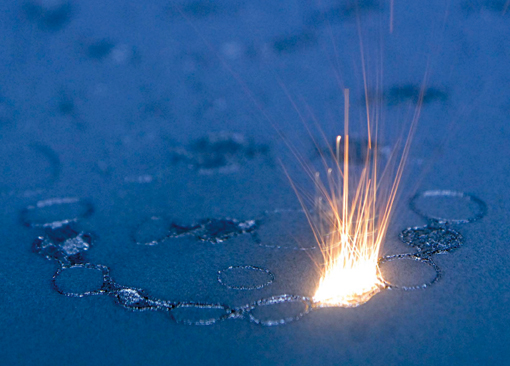It sounds like science fiction. 3D printers make the materialization of complex forms possible – simple, in any conceivable material, color, shape and surface. Does it already exist? Yes and no. We are on the very threshold of this successful experiment becoming broadly economically viable. The research investments are enormous, because the process’s potential is too. The first successful applications already exist.
Additive manufacturing (AM) is a relatively recent process. With it, absolutely precise three-dimensional shapes are created by computer, layer by layer, with the layers being joined either by a laser beam or an extruder – a nozzle squeezing out molten material. These layers represent the cross-section of the respective object being “printed,” one layer on top of the other. The great advantage of this method is the complete freedom of design it affords. Practically anything that software can image as a surface model can also be printed, free of the restrictions of conventional production methods such as milling or drilling. The process also essentially reduces the production of an
element to just one step. Things that were once expensively assembled with great effort from many component groups can now be made as one monolithic unit. The materials most often used are plastics and metals.
Pioneering work
 The hot spots for exploiting the process economically are in the US, Central Europe, China and Japan. Germany is doing pioneering work in 3D printing of metals. A process called selective laser melting (SLM) uses a laser beam to melt metal powder layer by layer into a finished product. The process is based on research done at the Fraunhofer ILT in Aachen, which has been exploring the field for nearly 20 years and holds patents that are already in use. The biggest equipment provider for the SLM process, such as EOS and Concept Laser, also come from Germany.
The hot spots for exploiting the process economically are in the US, Central Europe, China and Japan. Germany is doing pioneering work in 3D printing of metals. A process called selective laser melting (SLM) uses a laser beam to melt metal powder layer by layer into a finished product. The process is based on research done at the Fraunhofer ILT in Aachen, which has been exploring the field for nearly 20 years and holds patents that are already in use. The biggest equipment provider for the SLM process, such as EOS and Concept Laser, also come from Germany.
One practical example is the making of nozzles for the combustion systems of gas turbines. These nozzles, measuring about 10 cm in diameter, mix compressed air with fuel in an especially efficient way. The gas-fuel mixture is combusted cleanly, which in turn enhances the efficiency of the entire gas turbine and reduces harmful emissions. The inner design of these nozzles is so complex that they could simply not be made using conventional methods. This unit is only one of many in a turbine that could be perfected through AM. Amid all the euphoria, of course, engineers are also facing huge challenges. The materials made in SLM processes cannot be compared to those from conventional forging and casting procedures, especially regarding high-temperature applications.
Gigantic potential
And it’s not just the characteristics of the materials that cause headaches. Ensuring consistent high qu
ality in the product is another daunting challenge. On the one hand, more than 150 different factors influence the outcome of a printing procedure. On the other hand, the technology is still in its infancy, relatively speaking.
Another burning issue is product piracy. Units that are developed using a lot of effort and money can simply be 3D-scanned and copied. That is especially true for products that are mainly identified by their shape. If, however, we’re talking about high-performance structural components, then not only the shape but also the material’s specifications is important. Here, the know-how involved in the actual production process is the best piracy protection.
In 16 of the past 25 years, additive manufacturing has seen double-digit growth. Between 2010 and 2012 that figure reached the incredible average level of 27.4 percent annually. But AM still offers enormous growth potential in yet unexploited areas. The origins of the technology lie in the areas of product development and prototype production, which however constitute only 5-10 percent of the actual expenses for the developing companies. Between 90 and 95 percent are spent on production. And this is where the future growth potential lies. In the coming years, 3D printing or AM will cross the threshold into broad-based industrial use. It will change our world, replace established production methods in some areas, and further accelerate product development cycles.
Sebastian Piegert works for the Large Gas Turbine (LGT) at Siemens Energy as Group Lead for Additive Manufacturing
